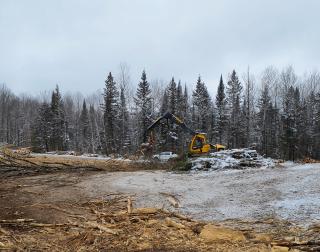Seeds of change: Assisted migration and the future of forests

NEW HAMPSHIRE—Throughout history, the Earth has experienced many changes in climate. Each left marks upon the planet’s landscapes and biodiversity. For instance, as the last Ice Age came to its close, the retreating glaciers made way for tree species to migrate into previously inhospitable environments in North America and Europe. But today, the abrupt speed of human-caused climate change poses new challenges to forest ecosystems worldwide—threatening their health and long-term resilience. With temperatures rising and precipitation patterns shifting, tree populations face difficulty adapting to these rapidly evolving conditions, while better adapted tree varieties lack the natural migration rate to shift their distribution amidst the rapid climate change.
In essence, the clock is ticking and trees are struggling to keep pace. To tackle this challenge, natural resource managers are turning to forward-thinking strategies to aid in the long-term health of forests in the face of climate change. One such strategy is assisted migration, and at the forefront of this approach is the Desired Regeneration through Assisted Migration, or DREAM, project.
Assisted migration involves the selection and relocation of non-local seed sources to areas better suited to future climate conditions. The DREAM project centers upon several main steps. The first revolves around developing tools to assess climate impact on plant species. During this planning stage, researchers look at what are called climate analogs.
“Climate analogs are locations with current climate conditions that closely resemble the projected future climate of another area,” explains Alejandro Royo, a research ecologist with the USDA Forest Service Northern Research Station. “For instance, if researchers are looking to introduce species or populations of a species in Wisconsin based on projections of a future warming climate, they might look to consider seed sources found in Indiana to the south, where average temperatures are warmer.”

The next component of assisted migration revolves around testing the physiological tolerances of the identified populations of tree species. During this stage, researchers subject seedlings to various climate conditions, such as drought or temperature fluctuations. With this data in hand, planners can identify tree species and populations that have the highest likelihood of surviving under future conditions.
At the final component of DREAM, researchers take seedlings from the identified seed sources and implement real-world trials across a variety of field conditions. During these real-world trials, tree varieties are evaluated for their seedling survival rates, as well as variations in growth based on environmental factors such as varying light levels, competition from neighboring vegetation and susceptibility to browsing by wildlife. These valuable insights will help to inform future planting strategies.
“We’re happy to report that in January we began harvesting at a site within the Chequamegon-Nicolet National Forest in Wisconsin,” says Royo. “This is just one site where DREAM researchers will take the tree populations that we’ve identified using our climate analog models and that we have tested in the laboratory setting, and we will see how they do in real-life conditions.”
The expected outcomes from the DREAM project are immense. As the climate continues to exert pressure on natural systems of plant adaptation and natural migration, DREAM serves as a valuable tool for land managers seeking to ensure forest health and resilience amidst an uncertain future.
